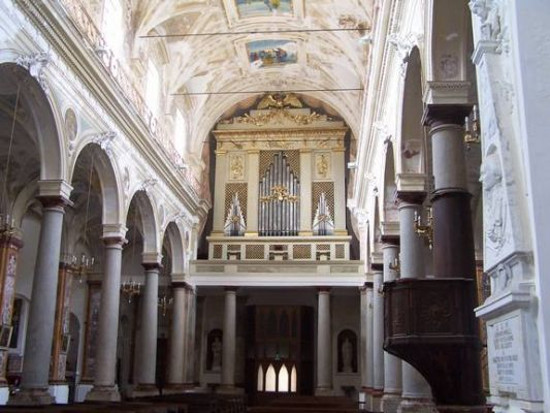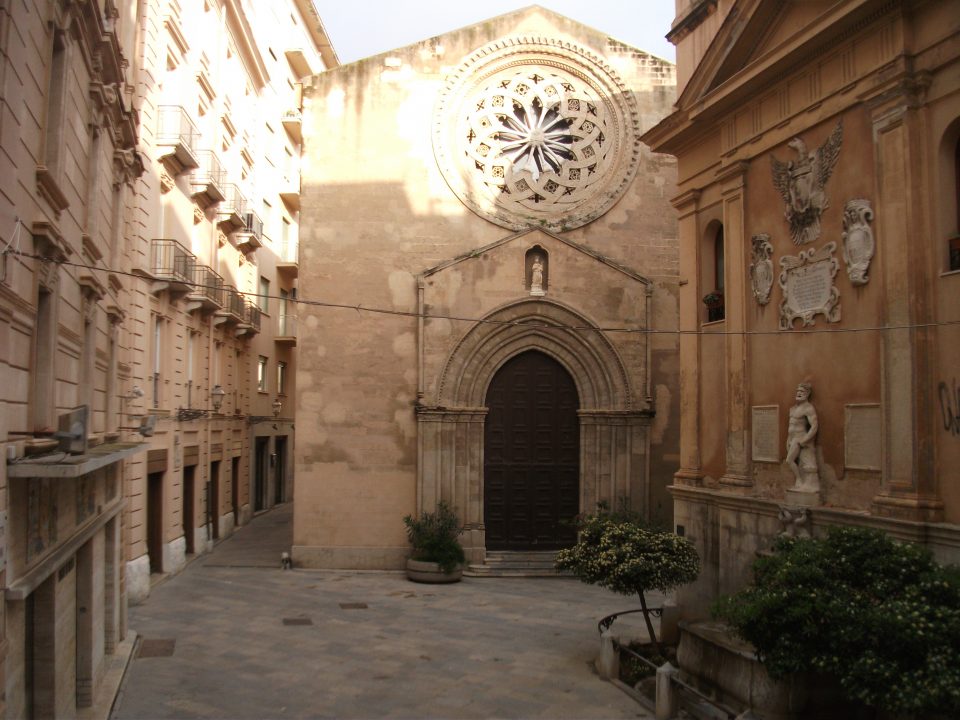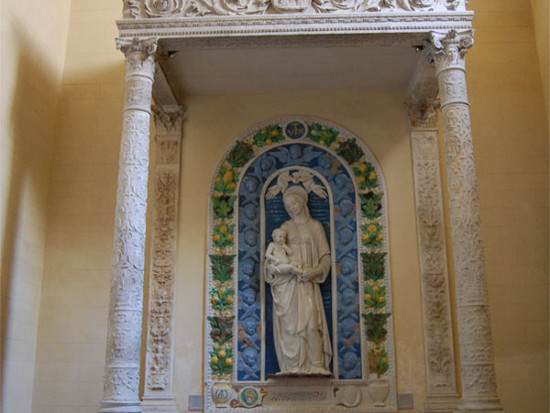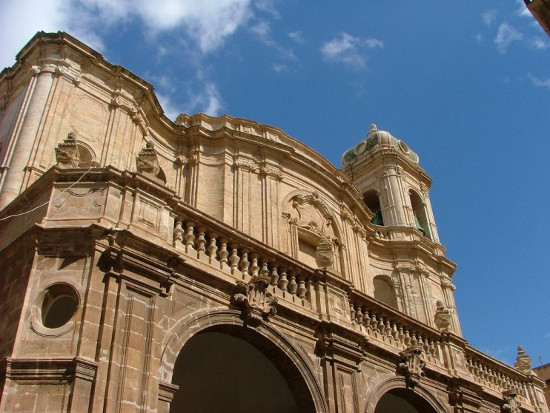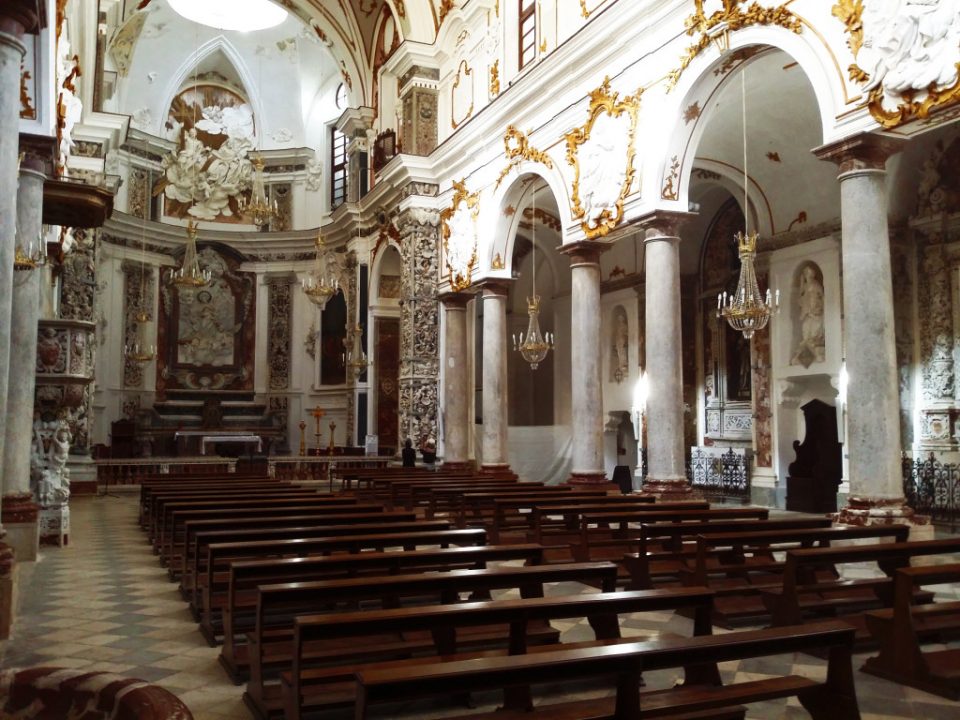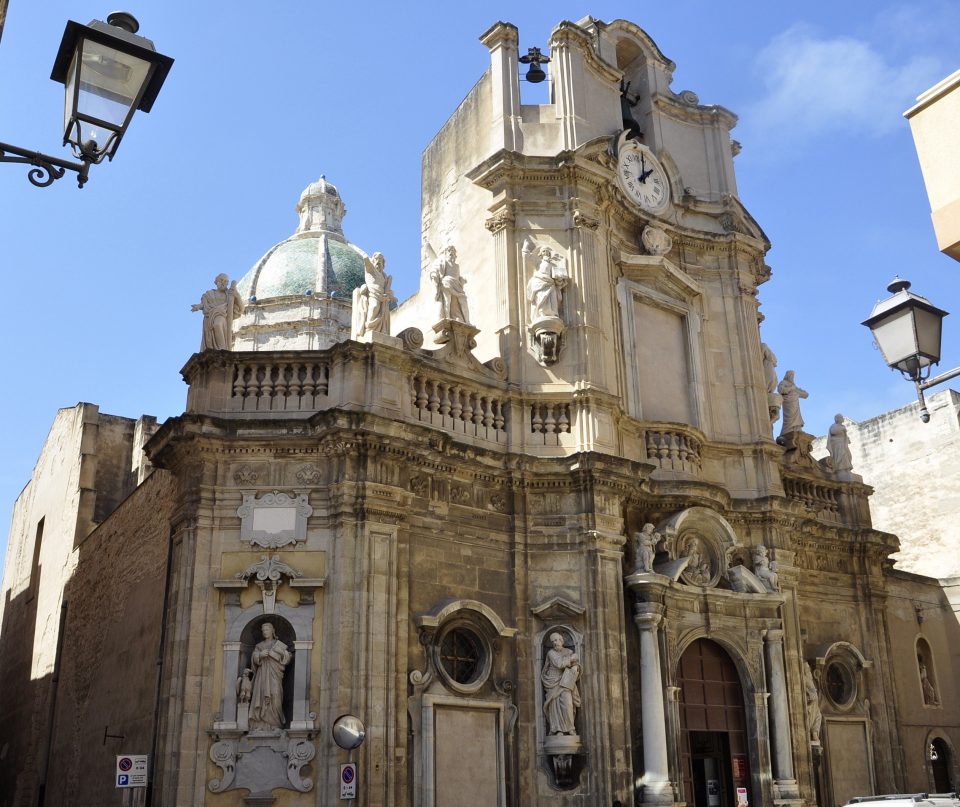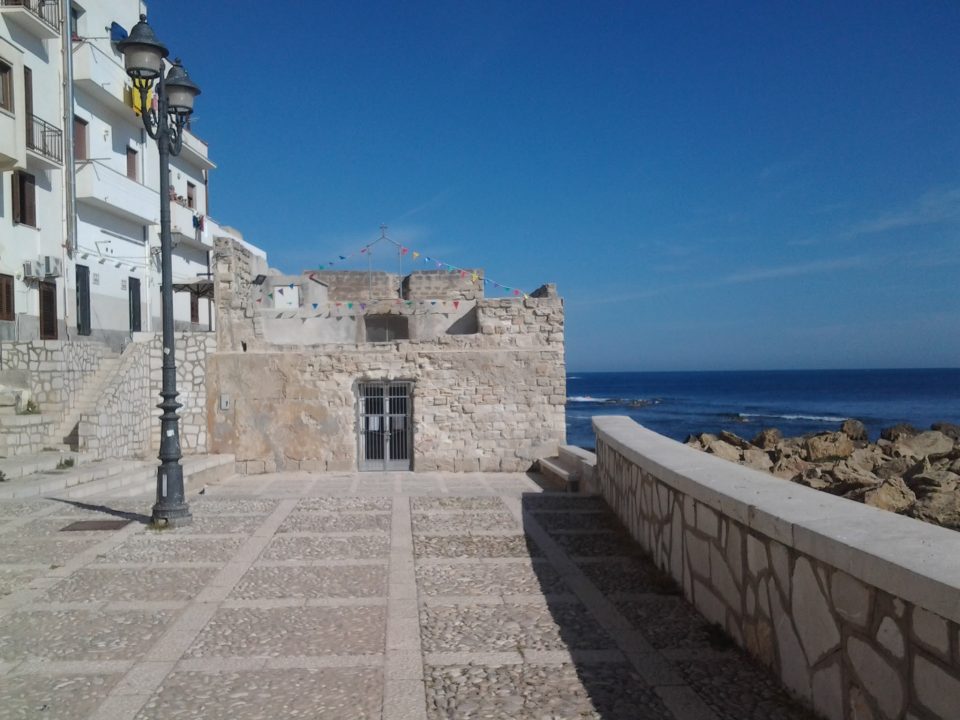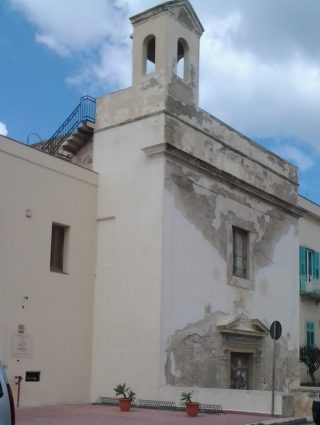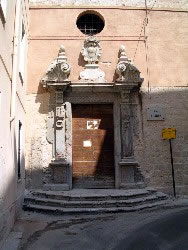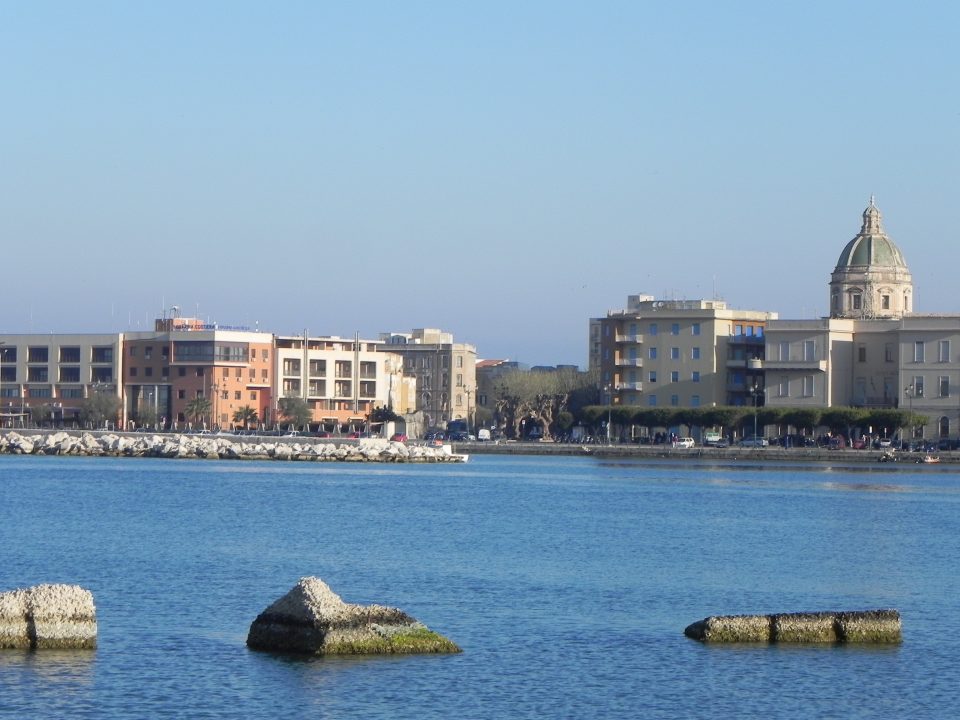There are several churches in Trapani centre. Almost all are very ancient and of value. Many are abandoned. Some, such as Jesuits Church, have been restored. Many ancient churches are still open to faithful.
Best Trapani churches
San Pietro Church
Located in “largo San Pietro”.
Saint Peter (San Pietro) district was the first inhabited part of Trapani. Here Elimi settled around 1260 BC after descending from Erice. In the place where, according to ancient tradition, the first of the Apostles preached, Christians built the church of St.Peter. It was rebuilt between 1695 and 1753.
Inside Saint Peter church there are paintings by Andrea Carreca and Rosario Matera. Andrea Carreca was a painter born in Trapani in 1590. There are some sculptures by Giuseppe Milanti and Mario Ciotta and others inspired by Gagini.
Organ in St. Peter Church
A great Organ artistically built from 1836 by Francesco La Grassa is kept inside St.Peter Church. The organ is the largest in Europe and one of the most famous instruments in the world.
Three people simultaneously can play the instrument. In fact it has three mechanic consoles. One is in the middle with three 70 keys-keyboards. Two are at each side with two keyboards each. Totally eighty registers drive 5,000 pipes.
It reproduces the sound effects of brass, trumpet, cymbals, trumpets, horns, oboe, saxophone and bassoon, violin, cello, clarinet, drums, flute and bagpipes. They say it can reproduce even the human voice.
After years of abandonment, the organ has been repaired and was inaugurated in 2003 to the presence of the President of the Republic.
Francesco La Grassa
Francesco La Grassa, brilliant Sicilian organ builder, completed his masterpiece in 1842. He was the genius of the organ in St.Peter church because he projected and built the whole organ by himself.
La Grassa didn’t put together parts of the instrument built by different factories, but he made himself every part. He was an excellent crafter in every single art: he was carpenter, machinist, blacksmith, metal worker, mechanic, manufacturer of skins for bellows, manufacturer of keyboard keys, tin worker and he was especially an egregious tuner.
Francesco La Grassa designed even the outward form of the organ. He also sculpted the allegorical symbols of the different musical instruments. So this is a great and very original work.
Let’s visit more churches
Sant’Agostino Church
Located in piazza Saturno.
Next to San Pietro discrict there is Biscottai discrict with piazza Scarlatti. I think the last is in honour of the famous baroque composer born in Palermo in 1660. In this square the building of the Bank of Italy occupies the place where previously Garibaldi Theatre stood. Built in 1844 the theatre was destroyed during the Second World War and never rebuilt.
Nearby there is St. Augustine Church, located in Piazza Saturno. Built in the fourteenth century, it is one of the oldest churches in Trapani. According to the tradition, Cardinal Arrigo Beccatellis built a hospice for Templars adjacent to the church. He gave the Knights his palace to make of it their headquarters in western Sicily. In fact during the First Crusade many pilgrims and soldiers travelling to the Holy Land left from the port of Trapani.
The second world war partially destroyed several times the church. Luckly it preserves the original facade with a Gothic portal and the magnificent rose window with interwoven arches. On the door, inside a niche, there is a Madonna and Child by Gagini.
In the neighborhood there are also the Fardelliana Library and some churches such as Saint Mary of Jesus.
Santa Maria di Gesù church
Located in via Santa Elisabetta.
Franciscan friars built Santa Maria di Gesù church and the adjoining convent in the sixteenth century, incorporating the Chapel of the Consulate of Lucchesi. It has a plant similar to the Dome in Monreale and keeps a Madonna of the Angels by Andrea della Robbia (Florentine sculptor and ceramist born in 1435). There are also the paintings of San Domenico and San Francesco by V. Carreca, and maybe a tinned terracotta bas-relief topped by a marble platform by Antonello Gagini (Renaissance sculptor and architect born in Palermo).
San Nicola church
Located in via Carreca
Into the neighborhood with the same name there is St.Nicholas church, which Belisarius built in 536 as a Church of the Ascension. So, this is among the oldest churches in Trapani. Until 1558 it was of greek rite. In 1749 architect Giovanni Amico enlarged it. It keeps inside several valuable works of art: a marble triptych depicting Christ between San Pietro and San Nicolò, peraphs by Vincenzo Gagini. The Crucifixion by Andrea Tipa. These great artists left their works in many sicilian churches.
Tipa were a family of sculptors and carvers (Trapani eighteenth century – nineteenth century) famous for their fine compositions in alabaster, coral, ivory, amber and shell. Their favorite themes were sacred and mythological scenes, wayside crosses, crucifixes, nativity scenes and cameos.
In the same church there are also paintings portraying St.Dionysius and St.Athanasius by Bernardino La Francesca, the Sacred Heart with the Virgin and Saint Michelle by Rosario Matera, an Ascension probably by Federico Zuccaro (known Umbrian Mannerist painter born in 1539). Also a San Nicola by Giacomo Tortilla and a complex sculpture of wood, canvas and glue representing Christ with the two thieves, made by craftmen from Trapani.
Sadly san Nicola Church is rarely open.
San Lorenzo Church
The Cathedral, dedicated to Saint Lorence, is located in Corso Vittorio Emanuele. Built in 1421, it has undergone several modifications over the centuries. In 1748 the architect Biagio Amico designed its current look. Among others it keeps inside a painting of the Crucifixion attributed to the Flemish painter Van Dyke. Then a sculpture of the Dead Christ by Giacomo Tartaglia, in the local stone named “incarnata”. Finally, the Eternal Father by Domenico La Bruna and a San Giorgio by Andrea Carreca.
The Jesuits Church
Located in Corso Vittorio Emanuele
Not far away the Cathedral there is the Jesuits Church. Jesuits arrived in Trapani in 1581 and in 1596 they started to build the church. Attached to the church was a college, now the Liceo Classico. Inside the church, Bartolomeo Sanseverino decorated the walls with plasters and with marble. In the XVIII century the architect Biagio Amico built the chapel of Sant’Ignazio at the left of the apse. The church contains a marble icon of the Immacolata by Ignazio Marabutti, a wooden wardrobe by Pietro Orlando, a wooden Crucifixion by Giuseppe Milanti, a painting of Sant’Ignazio by Vito Carreca, a painting of San Francesco Saverio by Pietro Novelli.
Purgatory Church
Located in via San Francesco d’Assisi
Anyone interested in the religious traditions cannot miss to visit the Purgatory Church, which houses “Misteri”, twenty sculptures representing Passion of Christ. People carry them in procession on Holy Friday. This is the most important event of the year in Trapani. The architet Biagio Amico in 1712 modified the church built in 1688, as we see it now. It features twelve statues of the apostles by Alberto Orlando.
San Liberale church
Located in piazzetta San Liberale
A few steps from Torre di Ligny there is the small Saint Liberale church . Coral fishermen built it in the early years of the 17th century. They dedicated it to their Patron Saint. The lovely church is built on rocks and has an outer surface made from tufa. Completed renovated inside it needs restoration again because a part of facade broke down.It is open for services.
Cappuccini church
Another small church is located in Piazza Generale Scio.
This is Cappuccini Church or Chiesa dell’Epifania, built in 1619.
A large door located under road level characterizes its facade.
Internally there is only one nave.
A convent was attached to it.
Now it hosts Kandinskij Academy of Fine Arts and has a lovely garden inside.
Santa Lucia church
Coral fishermen built also Santa Lucia church, in 14th century.
It is located in Via dei Cappuccini
In 1783 its doorway was rebuilt in Baroque Style.
Part of the majolica flooring inside belongs to the Regional Pepoli Museum.
Now this church has been abandoned for many years. St. Francesco of Assisi church preserves the statue of the patron saint.
San francesco d’Assisi church
Located in via Barlotta
From the port of Trapani or from the walls of North wind you will notice the beautiful dome of the church of San Francesco d’Assisi. It rises among the old and characteristic houses of the historic centre of the town. Two cupolas flanks its dome. One was for the watch and the other for the church bells.
The original church and adjacent convent were built in the first half of 13th century. They were rebuilt in the second half of 16th century. Inside there are sculptures on the walls depicting the “Virtù Morali”(Moral Virtues) completed by Cristoforo Milanti from Trapani. In the 18th century the architect Biagio Amico embellished the entrance of the convent with a classical-style door. The church has the form of a Latin cross with a single nave, with side chapels and a transept.
source
http://trapaniedintorni.altervista.org
Municipality Trapani Tour Guide
